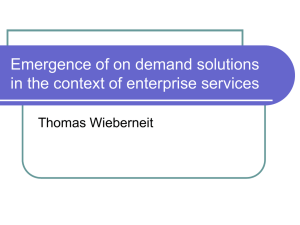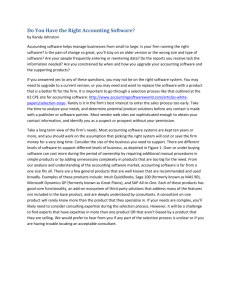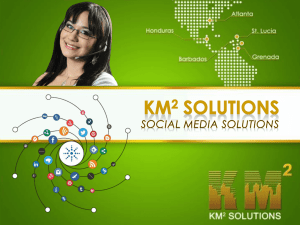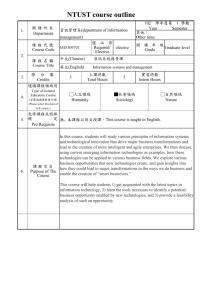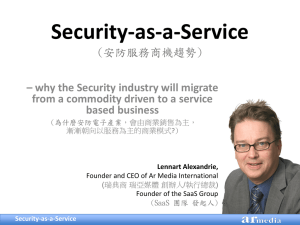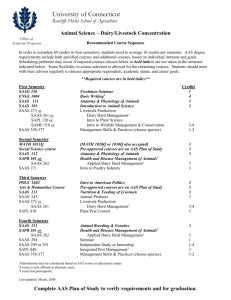SaaS Modeling Tool for Personalization
advertisement
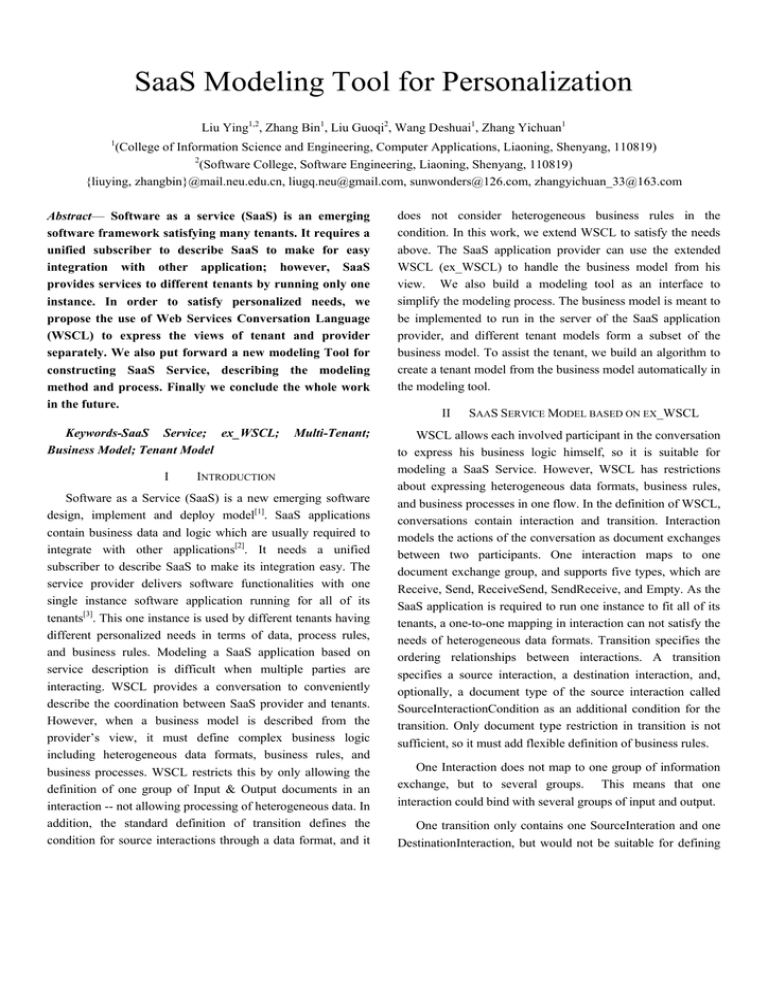
SaaS Modeling Tool for Personalization
Liu Ying1,2, Zhang Bin1, Liu Guoqi2, Wang Deshuai1, Zhang Yichuan1
1
(College of Information Science and Engineering, Computer Applications, Liaoning, Shenyang, 110819)
2
(Software College, Software Engineering, Liaoning, Shenyang, 110819)
{liuying, zhangbin}@mail.neu.edu.cn, liugq.neu@gmail.com, sunwonders@126.com, zhangyichuan_33@163.com
Abstract— Software as a service (SaaS) is an emerging
software framework satisfying many tenants. It requires a
unified subscriber to describe SaaS to make for easy
integration with other application; however, SaaS
provides services to different tenants by running only one
instance. In order to satisfy personalized needs, we
propose the use of Web Services Conversation Language
(WSCL) to express the views of tenant and provider
separately. We also put forward a new modeling Tool for
constructing SaaS Service, describing the modeling
method and process. Finally we conclude the whole work
in the future.
does not consider heterogeneous business rules in the
condition. In this work, we extend WSCL to satisfy the needs
above. The SaaS application provider can use the extended
WSCL (ex_WSCL) to handle the business model from his
view. We also build a modeling tool as an interface to
simplify the modeling process. The business model is meant to
be implemented to run in the server of the SaaS application
provider, and different tenant models form a subset of the
business model. To assist the tenant, we build an algorithm to
create a tenant model from the business model automatically in
the modeling tool.
Keywords-SaaS Service; ex_WSCL;
Business Model; Tenant Model
WSCL allows each involved participant in the conversation
to express his business logic himself, so it is suitable for
modeling a SaaS Service. However, WSCL has restrictions
about expressing heterogeneous data formats, business rules,
and business processes in one flow. In the definition of WSCL,
conversations contain interaction and transition. Interaction
models the actions of the conversation as document exchanges
between two participants. One interaction maps to one
document exchange group, and supports five types, which are
Receive, Send, ReceiveSend, SendReceive, and Empty. As the
SaaS application is required to run one instance to fit all of its
tenants, a one-to-one mapping in interaction can not satisfy the
needs of heterogeneous data formats. Transition specifies the
ordering relationships between interactions. A transition
specifies a source interaction, a destination interaction, and,
optionally, a document type of the source interaction called
SourceInteractionCondition as an additional condition for the
transition. Only document type restriction in transition is not
sufficient, so it must add flexible definition of business rules.
I
Multi-Tenant;
INTRODUCTION
Software as a Service (SaaS) is a new emerging software
design, implement and deploy model[1]. SaaS applications
contain business data and logic which are usually required to
integrate with other applications[2]. It needs a unified
subscriber to describe SaaS to make its integration easy. The
service provider delivers software functionalities with one
single instance software application running for all of its
tenants[3]. This one instance is used by different tenants having
different personalized needs in terms of data, process rules,
and business rules. Modeling a SaaS application based on
service description is difficult when multiple parties are
interacting. WSCL provides a conversation to conveniently
describe the coordination between SaaS provider and tenants.
However, when a business model is described from the
provider’s view, it must define complex business logic
including heterogeneous data formats, business rules, and
business processes. WSCL restricts this by only allowing the
definition of one group of Input & Output documents in an
interaction -- not allowing processing of heterogeneous data. In
addition, the standard definition of transition defines the
condition for source interactions through a data format, and it
II
SAAS SERVICE MODEL BASED ON EX_WSCL
One Interaction does not map to one group of information
exchange, but to several groups. This means that one
interaction could bind with several groups of input and output.
One transition only contains one SourceInteration and one
DestinationInteraction, but would not be suitable for defining
concurrent structured transitions. In concurrent structured
transitions,
the
exchange
document
of
several
SourceInteractions must all satisfy the constraints and the
transition triggers for the DesitionationInteraction to be
executed. We therefore extend the definition of transition to
allow it to have several SourceInterations and only one
DestinationInteraction.
We also modify the transition
condition SourceInteraction, and allow it not only to contain
elements of the exchange document but also their compound
expressions.
When triggering a transition in a business process, there are
business rules for its precondition except the document type
restriction in source interactions. We add business rules in
the definition of transition and require them to be part of
compound logic expressions to constrain attributes in the
interaction’s I/O.
III
SAAS SERVICE MODELING
In this paper, SaaS service model based on extended
WSCL uses conversation as basic element for describing its
business logic. When constructing a SaaS application based on
Web Service, the provider could construct a main process
firstly, and then describe it as Business Model by extended
WSCL. When a tenant wishes to subscribe to the SaaS
application, he could choose the interactions and a sequence of
them included in business model. According to his choice, the
provider separates their jointly owned interactions from the
business model, inverts the operations in them, and produces a
tenant model. The tenant gets his model from his view, and
does not need to know all of the complex business logic in the
business model. If he wants more functionality or a different
business flow, he could send his personalized requirement to
the provider. The provider may modify his business model by
adding new interactions or transitions or new interface
definitions, and publish a new model.
For convenience to both the provider and the tenants, we
provide a modeling tool. We can use it to create an effective
state diagram and to document WSCL for business service.
The tool implements two types of functional modules, which
are SaaS Service state diagram modeling and WSCL document
conversion with state diagrams. The first functional model is
implemented with graphical editor framework (GEF) and rich
client platform (RCP). The second functional model utilizes
reverse engineering to transform WSCL into a state diagram
and vice versa. The interface for the modeling tool is shown in
Figure 6.
Figure 1. Modeling Tool for SaaS Service
In addition, the tool provides for obtaining the tenant
model from the service model according to the tenant’s
personalized policy automatically. Firstly, we transform the
WSCL document of the service model to a graph, as described
by the work of Daniela et al[4]. Secondly, as we focus on
different processes for customization in this paper, we describe
how to implement to choose one sub-process from several
ones and delete the unselected branches in the process.
IV
CONCLUSIONS
This paper proposes a modeling method based on Web
services for SaaS applications with multi-tenancy support. We
have constructed a demonstration version to run the SaaS
application in this way. Adding running information in WSCL
is the goal of our future work.
V
ACKNOWLEDGEMENT
This research is supported by “National Hi-tech Research and
Development Project (863) of China” (2009AA01Z122), “National
Natural Science Foundation of China under grants” (60903009,
61073062) and “Natural Science Foundation of LiaoNing Province”
(20102061).
REFERENCES
[1]
[2]
[3]
[4]
Iod, Sotware as a Service, Kogan Page Ltd, 2002.
Sun Wei, Kuo Zhang, Shyh-Kwei Chen, etc. “Software as a Service:
An Integration Perspective”, ICSOC 2007, pp 558-569.
Thomas Kwok, Thao Nguyen and Linh Lam.A. “Software as a Service
with Multi-tenancy Support for an Electronic Contract Management
Application”, 2008 IEEE International Conference on Services
Computing, pp 179-186.
Daniela G, Juan C C, Mokrane B.Behavioral matchmaking for service
retrieval. ICWS '06. International Conference on Sept, 2006 ,145-152
